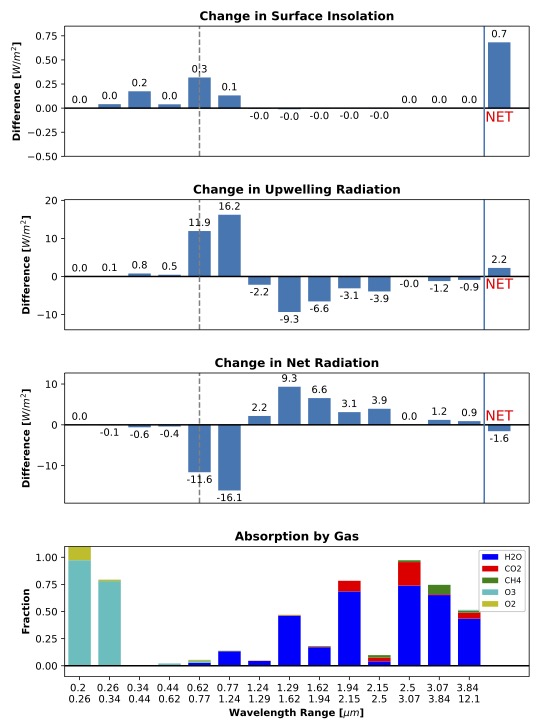Sensitivity of Atmospheric Heating to Solar Spectral Albedo Over Cryospheric Surfaces
Multiple Earth system models (ESMs) discretize surface albedo into two semi-broad bands comprising UV/visible and near-infrared (NIR) wavelengths. We investigate the atmospheric forcing due to resolving the spectral surface albedo with a modified version of the Snow, Ice, and Aerosol Radiative model (SNICAR), used by CESM and E3SM over snow on ice and land. We extended SNICAR-ADv4 to simulate liquid water surfaces in order to simulate albedo accurately over ocean, lakes, and ponded ice. We flux-weighted the high-resolution SNICAR spectral surface albedo into the 14 moderate-resolution spectral bands used by the Shortwave Rapid Radiative Transfer Model (RRTMG-SW). We then compared shortwave atmospheric heating simulated by RRTMG with 14-band spectral albedo to the heating based on the semi-broad band albedo approximation used in E3SM and CESM. While the spectrally resolved albedo causes an overall small snow-albedo brightening of ~0.5% (2.2 W m-2) relative to the semi-broadband, changes to the flux within each RRTM band are much more pronounced. For example, the spectral albedo increases the flux in two dominant bands that span 0.62- 1.24 μm by ~20.6% (28.1 W m-2) in a midlatitude summer profile. Meanwhile, at longer wavelengths (1.24- 2.50 μm) the spectral albedo darkens the surface by ~81.3% (25.6 W m-2).
The climatological albedo bias caused by the semi-broadband approximation is primarily due to too-weak surface reflectance being used in the two bands spanning 0.62–1.24 μm partially compensated by too-strong surface reflectance in the remaining NIR bands. The spectrally resolved upwelling NIR radiation decreases relative to the semi-broadband approximation, and thereby reduces overall atmospheric heating rates. Interestingly, the change in total upwelling irradiance is of opposite sign to the change in heating rate because the spectral increases in upwelling flux occur in relatively transparent bands, whereas all of the reduction in upwelling fluxes occurs in strong water vapor bands. Thus, the implementation of a spectrally resolved albedo reduces heating rates of both the surface and the atmosphere! The semi-broadband approximation causes much larger biases over snow (due to its larger variation in spectral albedo) than over liquid- or ice-covered surfaces.

